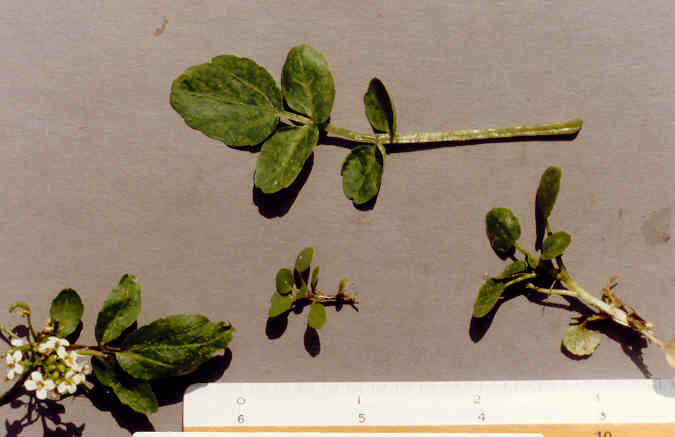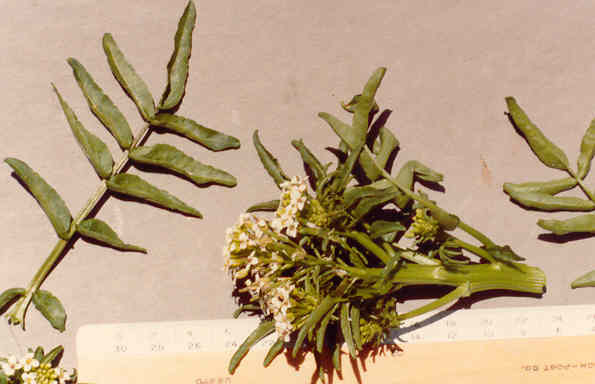
Rorippa nasturtium-aquaticum (L.) Hayek
=Nasturtium officinale
Brassicaceae
(Mustard Family)
Europe
Water Cress
 |
Rorippa nasturtium-aquaticum (L.) Hayek=Nasturtium officinaleBrassicaceae
(Mustard Family)
Europe
Water Cress
|
Plant Characteristics:
Aquatic perennial with prostrate or ascending stems 1-6 dm. long, rooting
freely, leaves pinnate, glabrous, 1-10 cm. long, with 3-11 ovate lfts. 5-25 mm.
long, subentire; pedicels divergent; fls. white, 3-4 mm. long, petals distinctly
clawed, twice the length of the sepals; fr. spreading to +/- erect, 10-15 mm.,
narrowly oblong, straight to upcurved; pedicels +/- spreading, +/- straight, not
bracted, junctions not flat, lower 8-15 mm.; style < 0.5 mm. or none; seeds,
two rows per chamber, +/- 1 mm.
wide, +/- round.
Habitat:
Many communities below 8000 ft., quiet water, wet banks; cismontane and
desert. March-Nov.
The cultivated Water-Cress.
Name:
From an old Saxon word, rorippon and nasus tortes,
twisted nose-alluding to the pungent smell of the plant.
Aquaticum means found in the
water. (Dale 85).
General:
Very common in the freshwater portions of the study area.
Photographed along Back Bay Dr. between Big Canyon and the old Salt Works
dike. (my comments). Ancient Persians were advised to feed
water cress to their children to improve their growth.
Romans considered it excellent food for people with deranged minds.
Pliny (79-23 AD) lists over 40 medicinal uses for water cress.
Water cress contains substantial quantities of vitamins A,B,C, & B2
as well as iron, copper, magnesium and calcium.
It is low in carbohydrates and is good for diabetics. It has more iron
than spinach. The plant must live
in cold flowing water. This plant
is not a relation to Genus Tropaeolum
which, because of its pungent edible leaves has been given the common name of
nasturtium. The plant has been used
in sandwiches, soups and salads. (Coon
163). The best parts
are the upper stems, the taste is typical of the mustard family-peppery.
Most hikers and backpackers find it delicious as is but if in polluted
water it should be cooked and thoroughly rinsed in pure water.
American Indians used the plant for liver and kidney trouble as well as
to dissolve gallstones. (Clarke
96-98). Water-cress in common to wet areas up
to 8,000 feet throughout much of the Cahuilla Indian territory (the Colorado
desert, the San Bernardino and San Jacinto Mountains).
This aquatic perennial was eaten fresh in the spring or cooked like
spinach and flavored prior to eating. (Bean
& Saubel 90). Native
Americans used the herb for liver and kidney trouble and to dissolve kidney
stones. J.E. Meyers of the Botanical
Gardens of Hammond, Indiana states that watercress is one of the best sources of
Vitamin E. (Hutchens 212).
Parkinson in 1640 says, "Leaves or juice applied to the face or
other parts troubled with freckles, pimples, spots or the like, at night and
washed away in the morning. The
juice mixed with vinegar to the forehead is good for lethargy or drowsy
feeling."
Coronado found it near the Gila River in Arizona and in 1769 Padre Crespi
speaks of it. In 1806 Lewis and Clark found it in Oregon.
Indians used the plant for liver and kidney trouble
and to dissolve gallstones. It
is now commonly used for salads and to garnish other dishes.
(Sweet 6). Rorippa nasturtium-aquaticum, a non-native plant was
used by the Luiseno as greens. The
northern Diegueno boiled the leaves and the Kawaiisu boiled or ate them raw,
usually with salt. (Campbell 140). The larvae of the Cabbage White butterfly, Pieris
rapae, feed on members of the Mustard family including cabbage, broccoli,
mustards, watercress and peppergrass. (No author, sbnature, A
Journal of the Santa Barbara Museum of Natural History. Spring 2004/Vol. 2 No.1,
6-8). A fairly large genus of temperate regions.
(Munz, Flora So. Calif. 298.
Text Ref:
Abrams, Vol. II 276; Dale 84; Hickman, Ed. 435; Munz, Calif.
Flora 240; Munz, Flora So. Calif.
298; Roberts 16.
Photo Ref: April 2 84 # 15;
June-July 87 # 12.
Identity: by R. De Ruff.
First Found: April 1984.
Computer Ref: Plant Data
12.
Have plant specimen.
Last edit 10/17/04.
 |
 |
June Photo April Photo